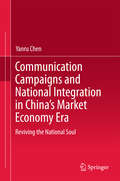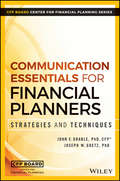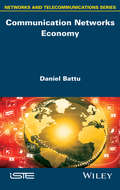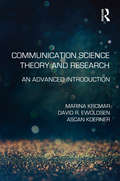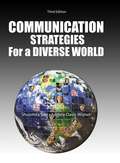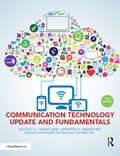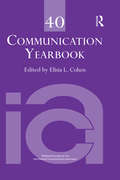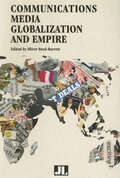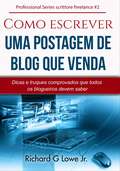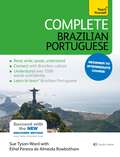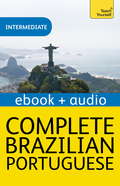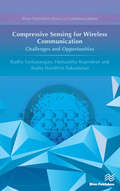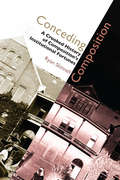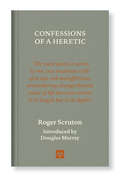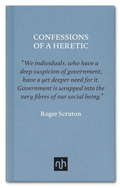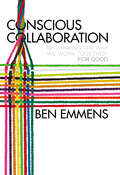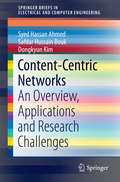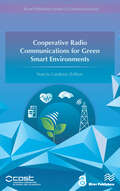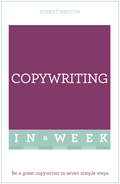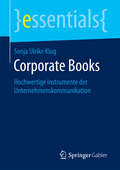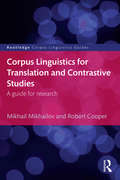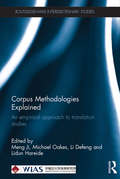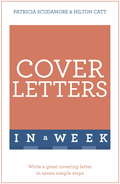- Table View
- List View
Communication Campaigns and National Integration in China's Market Economy Era: Reviving the National Soul
by Yanru ChenThis book adopts the method of grounded theory in studying national communication campaigns in China, referred to as propaganda campaigns in the Chinese linguistic context. The study provides an exploratory and descriptive analysis of the ways in which the media in China fulfilled their function of building a Socialist spiritual civilisation and maintaining national integration during state propaganda campaigns. Explanations for the success and limitations of the campaigns are clearly expressed and combined with cautious statements on the limited role of the media in the process of national integration. The three major communication campaigns detailed in this book offer revelations regarding how to maintain mass morale and revive the national spirit at a time when economic pursuits and aspirations seem to be the top priority for individuals and institutions. A chief premise underpinning this study is that economic growth is not to be equated with social progress or human development, the latter encompassing a far more profound spiritual dimension, which takes far more delicate efforts to accomplish.
Communication Essentials for Financial Planners: Strategies and Techniques
by John E. Grable Joseph W. GoetzCommunication Essentials for Financial Planners tackles the counseling side of practice to help financial planners build more productive client relationships. CFP Board’s third book and first in the Financial Planning Series, Communication Essentials will help you learn how to relate to clients on a more fundamental level, and go beyond "hearing" their words to really listen and ultimately respond to what they're saying. Expert coverage of body language, active listening, linguistic signals, and more, all based upon academic theory. There is also an accompanied set of videos that showcase both good and bad communication and counseling within a financial planning context. By merging written and experiential learning supplemented by practice assignments, this book provides an ideal resource for any client-facing financial professional as well as any student on their pathway to CFP® certification. Counseling is a central part of a financial planner's practice, and attention to interpersonal communication goes a long way toward progressing in the field; this guide provides practical instruction on the proven techniques that make a good financial planner great. The modern financial planning practice is more than just mathematics and statistical analysis—at its heart, it is based on trust, communication, and commitment. While interpersonal skills have always been a critical ingredient for success, only recently has this aspect been given the weight it deserves with its incorporation into the certification process. Communication Essentials for Financial Planners provides gold-standard guidance for certification and beyond.
Communication Networks Economy
by Daniel BattuThe rapid economic expansion of the Western countries during the XX century has favored the idea that Economy growth could be mathematically linked to the manufacturing processes and to a correct management and distribution of the common tools necessary in the social life. A specific geographical management and an adequate telecom framework are necessary for the success of the economic activities. Conversely, the telecom network should answer to the needs of the national economy. On these two basic topics, several errors have been expressed and can lead to non-useful investments.
Communication Pathways
by Joseph M. Valenzano III Melissa Broeckelman-Post Erin ParcellFrom the authors of The Speaker and The Speaker's Primer comes an innovative new textbook that covers hybrid communication course curriculum in an approachable way. Communication Pathways introduces to the market a handbook-style approach to the hybrid course, with concise chapters that emphasize communication theory. The authors chose to organize content around a communication-centric theme: dialogue. The first section of the text dedicates an entire chapter to the subject, unpacking the concept for students; the authors further incorporate and explicate dialogic communication as it applies to subsequent chapter concepts. This theme is unique to the text and is a central element of what the authors aim to accomplish: create competent, dialogic communicators who know how to advocate ideas civilly, explain complicated subjects, and disagree without being disagreeable in a variety of interactive settings.
Communication Science Theory and Research: An Advanced Introduction
by David R. Ewoldsen Marina Krcmar Ascan KoernerThis volume provides a graduate-level introduction to communication science, including theory and scholarship for masters and PhD students as well as practicing scholars. The work defines communication, reviews its history, and provides a broad look at how communication research is conducted. It also includes chapters reviewing the most frequently addressed topics in communication science. This book presents an overview of theory in general and of communication theory in particular, while offering a broad look at topics in communication that promote understanding of the key issues in communication science for students and scholars new to communication research. The book takes a predominantly "communication science" approach but also situates this approach in the broader field of communication, and addresses how communication science is related to and different from such approaches as critical and cultural studies and rhetoric. As an overview of communication science that will serve as a reference work for scholars as well as a text for the introduction to communication graduate studies course, this volume is an essential resource for understanding and conducting scholarship in the communication discipline.
Communication Strategies In A Diverse World
by Angela Wizner Shusmita SenCommunication Strategies in a Diverse World
Communication Technology Update and Fundamentals: 15th Edition
by August E. Grant Jennifer H. MeadowsCommunication Technology Update and Fundamentals has set the standard as the single best resource for students and professionals looking to brush up on how communication technologies have developed, grown, and converged, as well as what's in store for the future. The 15th edition is completely updated, reflecting the changes that have swept the communication industries. The first five chapters offer the communication technology fundamentals, including the ecosystem, the history, and structure--then delves into each of about two dozen technologies, including mass media, computers, consumer electronics, and networking technologies. Each chapter is written by experts who provide snapshots of the state of each individual field. Together, these updates provide a broad overview of these industries, as well as the role communication technologies play in our everyday lives. In addition to substantial updates to each chapter, the 15th edition includes: First-ever chapters on Big Data and the Internet of Things Updated user data in every chapter Projections of what each technology will become by 2031 Suggestions on how to get a job working with the technologies discussed The companion website, www.tfi.com/ctu, offers updated information on the technologies covered in this text, as well as links to other resources
Communication Yearbook 40
by Elisia L. CohenCommunication Yearbook 40 completes four decades of publishing state-of-the-discipline literature reviews and essays. In the final Communication Yearbook volume, editor Elisia L. Cohen includes chapters representing international and interdisciplinary scholarship, demonstrating the broad global interests of the International Communication Association. The contents include summaries of communication research programs that represent the most innovative work currently. Emphasizing timely disciplinary concerns and enduring theoretical questions, this volume will be valuable to scholars throughout the communication discipline and beyond.
Communication in Organizational Environments: Functions, Determinants and Areas of Influence
by Anna Rogala Sylwester BialowasThis book showcasesan interdisciplinary and comprehensive study of the issues related tocommunication in corporate environments. Including perspectives frompsychology, sociology and management science, Communication in Organizational Environments analyzes originalquantitative and qualitative research, and determines the functions, objectivesand conditions of effective internal communication. In this book, the authorsbridge the gap in the literature on the management of corporate internal communication,and provide a tool for measuring communication effectiveness. Useful as a guidefor internal communication managers in various organizations, this book is alsoimportant reading for academics in corporate communication, public relations,corporate management and behaviour, and human resource management.
Communications Media, Globalization, and Empire
by Oliver Boyd-BarrettAn exploration of the political economy of media, and to what extent global communications and popular entertainment continue to serve elite interests.In Communications Media, Globalization, and Empire, an international team of experts analyzes and critiques the political economy of media communications worldwide. Their analysis takes particular account of the sometimes conflicting pressures of globalization and “neo-imperialism.” The first is commonly defined as the dismantling of barriers to trade and cultural exchange and responds significantly to lobbying of the world’s largest corporations, including media corporations. The second concerns US pursuit of national security interests as response to “terrorism,” at one level and, at others, to intensifying competition among both nations and corporations for global natural resources.
Como escrever uma postagem de blog que venda
by Richard G Lowe Jr Nícolas PoloniEscrever um artigo que induza o leitor a tomar a decisão de fazer algo é uma arte. Esse é o principal foco do livro. Você aprenderá a criar um artigo que deixe o leitor interessado, instigado, informado e ainda o faça tomar uma decisão ao terminar a leitura.
Complete Brazilian Portuguese Beginner to Intermediate Course: Enhanced Edition
by Sue Tyson-Ward Ethel Pereira Rowbotham E Pereira RowbothamDo you want to develop a solid understanding of Brazilian Portuguese and communicate confidently with others?Through authentic conversations, vocabulary building, grammar explanations and extensive practice and review, Complete Brazilian Portuguese will equip you with the skills you need to use Brazilian Portuguese in a variety of settings and situations, developing your cultural awareness along the way.What will I achieve by the end of the course?By the end of Complete Brazilian Portuguese you will have a solid intermediate-level grounding in the four key skills - reading, writing, speaking and listening - and be able to communicate with confidence and accuracy. Is this course for me?If you want to move confidently from beginner to intermediate level, this is the course for you. It's perfect for the self-study learner, with a one-to-one tutor, or for the beginner classroom. It can also be used as a refresher course. What do I get?-18 learning units plus verbs reference and word glossary and revision section-Discovery Method - figure out rules and patterns to make the language stick -Teaches the key skills - reading, writing, listening, and speaking -Learn to learn - tips and skills on how to be a better language learner -Culture notes - learn about the people and places of Brazil-Outcomes-based learning - focus your studies with clear aims -Authentic listening activities - everyday conversations give you a flavor of real spoken Brazilian Portuguese-Test Yourself - see and track your own progress *Complete Brazilian Portuguese maps from Novice Low to Advanced Low level proficiency of ACTFL (American Council on the Teaching of Foreign Languages) and from A1 Beginner to B1/B2 Upper Intermediate level of the CEFR (Common European Framework of Reference for Languages) guidelines. What else can I use to learn Brazilian Portuguese?If you require an absolute Beginner course, you can try our Get Started in Brazilian Portuguese Absolute Beginner course: 9781444198539The audio for this course can be downloaded from the Teach Yourself Library app or streamed at library.teachyourself.com.Rely on Teach Yourself, trusted by language learners for over 75 years.
Complete Brazilian Portuguese Beginner to Intermediate Course: Enhanced edition
by Sue Tyson-Ward Ethel Pereira RowbothamDo you want to develop a solid understanding of Brazilian Portuguese and communicate confidently with others?Through authentic conversations, vocabulary building, grammar explanations and extensive practice and review, Complete Brazilian Portuguese will equip you with the skills you need to use Brazilian Portuguese in a variety of settings and situations, developing your cultural awareness along the way.What will I achieve by the end of the course?By the end of Complete Brazilian Portuguese you will have a solid intermediate-level grounding in the four key skills - reading, writing, speaking and listening - and be able to communicate with confidence and accuracy. Is this course for me?If you want to move confidently from beginner to intermediate level, this is the course for you. It's perfect for the self-study learner, with a one-to-one tutor, or for the beginner classroom. It can also be used as a refresher course. What do I get?-18 learning units plus verbs reference and word glossary and revision section-Discovery Method - figure out rules and patterns to make the language stick -Teaches the key skills - reading, writing, listening, and speaking -Learn to learn - tips and skills on how to be a better language learner -Culture notes - learn about the people and places of Brazil-Outcomes-based learning - focus your studies with clear aims -Authentic listening activities - everyday conversations give you a flavor of real spoken Brazilian Portuguese-Test Yourself - see and track your own progress *Complete Brazilian Portuguese maps from Novice Low to Advanced Low level proficiency of ACTFL (American Council on the Teaching of Foreign Languages) and from A1 Beginner to B1/B2 Upper Intermediate level of the CEFR (Common European Framework of Reference for Languages) guidelines. What else can I use to learn Brazilian Portuguese?If you require an absolute Beginner course, you can try our Get Started in Brazilian Portuguese Absolute Beginner course: 9781444198539The audio for this course can be downloaded from the Teach Yourself Library app or streamed at library.teachyourself.com.Rely on Teach Yourself, trusted by language learners for over 75 years.
Compressive Sensing for Wireless Communication: Challenges and Opportunities (River Publishers Series In Communications Ser.)
by Radha Sankararajan Hemalatha Rajendran Aasha Nandhini SukumaranCompressed Sensing (CS) is a promising method that recovers the sparse and compressible signals from severely under-sampled measurements. CS can be applied to wireless communication to enhance its capabilities. As this technology is proliferating, it is possible to explore its need and benefits for emerging applicationsCompressive Sensing for Wireless Communication provides:• A clear insight into the basics of compressed sensing• A thorough exploration of applying CS to audio, image and computer vision• Different dimensions of applying CS in Cognitive radio networks• CS in wireless sensor network for spatial compression and projection• Real world problems/projects that can be implemented and tested• Efficient methods to sample and reconstruct the images in resource constrained WMSN environmentThis book provides the details of CS and its associated applications in a thorough manner. It lays a direction for students and new engineers and prepares them for developing new tasks within the field of CS. It is an indispensable companion for practicing engineers who wish to learn about the emerging areas of interest.
Conceding Composition: A Crooked History of Composition's Institutional Fortunes
by Ryan SkinnellFirst-year composition became the most common course in American higher education not because it could “fix” underprepared student writers, but because it has historically served significant institutional interests. That is, it can be “conceded” in multiple ways to help institutions solve political, promotional, and financial problems. Conceding Composition is a wide-ranging historical examination of composition’s evolving institutional value in American higher education over the course of nearly a century. Based on extensive archival research conducted at six American universities and using the specific cases of institutional mission, regional accreditation, and federal funding, this study demonstrates that administrators and faculty have introduced, reformed, maintained, threatened, or eliminated composition as part of negotiations related to nondisciplinary institutional exigencies. Viewing composition from this perspective, author Ryan Skinnell raises new questions about why composition exists in the university, how it exists, and how teachers and scholars might productively reconceive first-year composition in light of its institutional functions. The book considers the rhetorical, political, organizational, institutional, and promotional options conceding composition opened up for institutions of higher education and considers what the first-year course and the discipline might look like with composition’s transience reimagined not as a barrier but as a consummate institutional value.
Confessions of a Heretic, Revised Edition: Selected Essays
by Roger ScrutonA revised edition of the Notting Hill Editions essay collection by the late Sir Roger Scruton with a new introduction by Douglas Murray.Confessions of a Heretic is a collection of provocative essays by the influential social commentator and polemicist Roger Scruton. Each &“confession&” reveals aspects of the author&’s thinking that his critics would probably have advised him to keep to himself. In this selection, covering subjects from art and architecture to politics and nature conservation, Scruton challenges popular opinion on key aspects of our culture: What can we do to protect Western values against Islamist extremism? How can we nurture real friendship through social media? Why is the nation-state worth preserving? How should we achieve a timely death against the advances of modern medicine? This provocative collection seeks to answer the most pressing problems of our age.In his introduction, the bestselling author and commentator Douglas Murray writes of what it cost Scruton to express views considered unpalatable, and of the importance of these ideas after Scruton&’s death.
Confessions of a Heretic: Selected Essays
by Roger ScrutonHard-hitting essays by acclaimed social commentator and philosopher Roger Scruton, guaranteed to provoke lively debateA wide-ranging selection that includes essays on architecture and modern art, the environment, politics, and culture.Each “confession” reveals aspects of the author’s thinking that his critics would probably have advised him to keep to himself. Roger Scruton challenges popular opinion on key aspects of our society: What can we do to protect Western values against Islamic extremism? How can we nurture real friendship in the digital age of social media and Facebook? How should we achieve a timely death against the advances of modern medicine? How should environmental policies be shaped by the government? This provocative collection seeks to answer the most pressing problems of our age.
Conscious Collaboration: Re-Thinking The Way We Work Together, For Good
by Ben EmmensWhen collaboration works, the results can be breath-taking! But it doesn't always deliver on its potential. Collaboration has been defined as "an unnatural act practiced by non-consenting adults". And often that's exactly what it is! Some collaboration can be painfully difficult with the result that problems are either ignored or smoothed over until the collaboration falters or disintegrates, or self-interest and personal agendas take over and conflict quickly arises. Collaboration and partnerships work well in the aid sector because they have to - no one body has the resources to solve massive problems on their own. Business often sees the advantages of collaboratively sharing costs without fully recognizing the shift in mindset that is required to take managers with a "winner takes all" worldview and get them performing effectively in a win-win world. Part of the solution lies in bringing consciousness to the workplace and developing it as a core competence. A conscious approach to business relationships, planning, and delivery can enable individuals and organizations to truly think about what they are doing, make changes where needed, and become more effective. It is a particularly effective way of managing the multiple and occasionally conflicting stakeholder objectives inherent in any collaborative project. The author draws on his experience in the aid sector and with non-profit organizations to describe the building blocks that underpin successful collaboration, and inspires us to re-think the way we work together, for good.
Content-Centric Networks: An Overview, Applications and Research Challenges (SpringerBriefs in Electrical and Computer Engineering #0)
by Syed Hassan Ahmed Safdar Hussain Bouk Dongkyun KimThis book introduces Content-Centric Networking (CCN), a networking paradigm that provides a simple and effective solution to the challenging demands of future wired and wireless communications. It provides an overview of the recent developments in the area of future internet technologies, bringing together the advancements that have been made in Information-Centric Networking (ICN) in general, with a focus on CCN. It begins with an introduction to the basics of CCN is followed by an overview of the current internet paradigm and its challenges. Next, an application perspective has been included, where the authors encompass the selected applications for CCN with recent refereed research and developments. These applications include Internet of Things (IoT), Smart Grid, Vehicular Ad hoc Networks (VANETs), and Wireless Sensor Networks (WSNs). The book is a useful reference source for practising researchers, and can be used as supporting material for undergraduate and graduate level courses in computer science and electrical engineering.
Cooperative Radio Communications for Green Smart Environments
by Narcis CardonaThe demand for mobile connectivity is continuously increasing, and by 2020 Mobile and Wireless Communications will serve not only very dense populations of mobile phones and nomadic computers, but also the expected multiplicity of devices and sensors located in machines, vehicles, health systems and city infrastructures. Future Mobile Networks are then faced with many new scenarios and use cases, which will load the networks with different data traffic patterns, in new or shared spectrum bands, creating new specific requirements. This book addresses both the techniques to model, analyse and optimise the radio links and transmission systems in such scenarios, together with the most advanced radio access, resource management and mobile networking technologies. This text summarises the work performed by more than 500 researchers from more than 120 institutions in Europe, America and Asia, from both academia and industries, within the framework of the COST IC1004 Action on "Cooperative Radio Communications for Green and Smart Environments". The book will have appeal to graduates and researchers in the Radio Communications area, and also to engineers working in the Wireless industry. Topics discussed in this book include: • Radio waves propagation phenomena in diverse urban, indoor, vehicular and body environments• Measurements, characterization, and modelling of radio channels beyond 4G networks• Key issues in Vehicle (V2X) communication• Wireless Body Area Networks, including specific Radio Channel Models for WBANs• Energy efficiency and resource management enhancements in Radio Access Networks• Definitions and models for the virtualised and cloud RAN architectures• Advances on feasible indoor localization and tracking techniques• Recent findings and innovations in antenna systems for communications• Physical Layer Network Coding for next generation wireless systems• Methods and techniques for MIMO Over the Air (OTA) testing
Copywriting In A Week: Be A Great Copywriter In Seven Simple Steps
by Robert Ashton Rob AshtonGreat copywriting just got easierIt's strange to think that there was a time when only the privileged few could read or write. The rest of us relied on the spoken word. Storytelling was used to pass knowledge on from one generation to the next. Now, most of us are literate and use the written word to gather information and inform our decision making. Increasingly we do this online, with social media and messaging enabling rapid, spontaneous global communication. But rather than freeing us from the need for clear, effective written communication, it actually makes good communication even more important. The less we communicate face to face, the greater the opportunity for misunderstandings. Of course, all writing communicates your message to people you cannot see and may never meet. It means you can influence more widely; it also means you must take care not to make assumptions aboutyour reader, especially those who see your public postings. Successful copywriting is constructed from carefully selected words, each with a clear purpose. It is written to prompt feelings, thoughts or actions. It is clear, concise and at times comforting. It is also comprehensible, even to those not yet confident users of your language. Reading this book, and following the techniques it introduces, will make you a more effective writer. Expertise in grammar is not needed as all the necessary jargon is simply defined and, anyway, some forms of business writing deliberately ignorerules. This book is for people who want to write for results. Each of the seven chapters in Copywriting In A Week covers a different aspect:- Sunday: Focusing your message- Monday: Using layout, pictures and colour to make words memorable- Tuesday: Writing effective letters- Wednesday: Making advertising work for you- Thursday: Communicating clearly with the media- Friday: Preparing promotional print- Saturday: Composing proposals and presentation visuals
Corporate Books: Hochwertige Instrumente der Unternehmenskommunikation (essentials)
by Sonja Ulrike KlugDieser Leitfaden führt durch alle Entwicklungsstadien von Unternehmensbüchern und zeigt, worauf es ankommt. Die Autorin erläutert das spezielle Vorgehen bei der Planung, Realisierung und Vermarktung von Corporate Books als Premium-Instrumenten der Unternehmenskommunikation, damit ihre Vorteile ausgeschöpft werden können. Unternehmensbücher erhöhen den Bekanntheitsgrad, stärken die Markenidentität, dienen als Zugpferd für Kampagnen und unterstreichen den Expertenstatus für ein Thema. Sie können von Konzernen, Mittelständlern, Kleinunternehmern und Solopreneuren gleichermaßen eingesetzt werden. Corporate Books wirken langfristig und beeinflussen die Wahrnehmung eines Unternehmens durch die Öffentlichkeit positiv.
Corpus Linguistics for Translation and Contrastive Studies: A guide for research (Routledge Corpus Linguistics Guides)
by Robert Cooper Mikhail MikhailovCorpus Linguistics for Translation and Contrastive Studies provides a clear and practical introduction to using corpora in these fields. Giving special attention to parallel corpora, which are collections of texts in two or more languages, and demonstrating the potential benefits for multilingual corpus linguistics research to both translators and researchers, this book: explores the different types of parallel corpora available, and shows how to use basic and advanced search procedures to analyse them; explains how to compile a parallel corpus, and discusses their uses for translation purposes and to research linguistic phenomena across languages; demonstrates the use of corpus extracts across a wide range of texts, including dictionaries, novels by authors including Jane Austen and Mikhail Bulgakov, and newspapers such as The Sunday Times; is illustrated with case studies from a range of languages including Finnish, Russian, English and French. Written by two experienced researchers and practitioners, Corpus Linguistics for Translation and Contrastive Studies is essential reading for postgraduate students and researchers working within the area of translation and contrastive studies.
Corpus Methodologies Explained: An empirical approach to translation studies (Routledge-WIAS Interdisciplinary Studies)
by Michael Oakes Meng Ji Li Defeng Lidun HareideThis book introduces the latest advances in Corpus-Based Translation Studies (CBTS), a thriving subfield of Translation Studies which forms an important part of both translator training and empirical translation research. Largely empirical and exploratory, a distinctive feature of CBTS is the development and exploration of quantitative linguistic data in search of useful patterns of variation and change in translation. With the introduction of textual statistics to Translation Studies, CBTS has geared towards a new research direction that is more systematic in the identification of translation patterns; and more explanatory of any linguistic variations identified in translations. The book traces the advances from the advent of language corpora in translation studies, to the new textual dimensions and shift towards a probability-variation model. Such advances made in CBTS have enabled in-depth analyses of translation by establishing useful links between a translation and the social and cultural context in which the translation is produced, circulated and consumed.
Cover Letters In A Week: Write A Great Covering Letter In Seven Simple Steps
by Pat Scudamore Hilton CattSunday: Understand the importance of first impressions and the common mistakes people make Monday: Ensure your application is taken seriously with a cover letter that is concise, complements your CV and is targeted to the job you have applied for Tuesday: Discover how to style and structure your cover letter with advice on forms of address, etiquette, fonts, margins and the importance of 'white space' Wednesday: Design your cover letter to engage your audience and overcome the competition for advertised jobs Thursday: Design a speculative cover letter to approach the invisible job market Friday: Learn how to address cover letters to agencies and recruitment consultants Saturday: Learn from your applications, whether successful or not, and develop your writing style for the future
